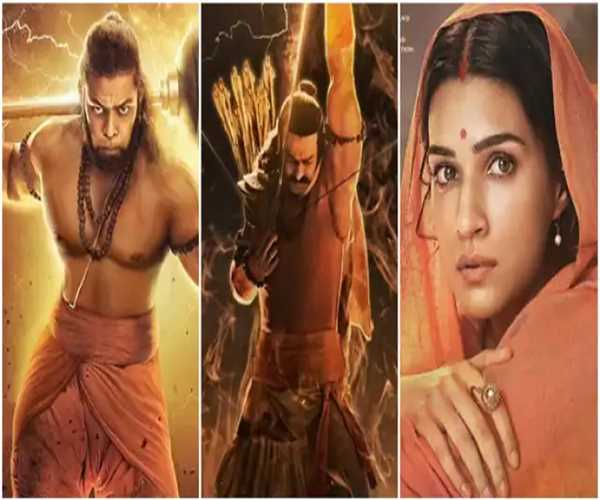Search here

24-Jun-2023 , Updated on 6/24/2023 10:01:07 AM
What was the controversy behind Adipurush , the latest upcoming film in India
Summary behind controversy of Adipurush in india
- Adipurush , the recent mythological film has been wrapped by controversies brings the film in picture to be banned
- The dialogues written by Manoj Muntashir Shukla have received the most criticism, with many criticizing the characters' tapori-style dialogue.
- Lord Hanuman's utterances of "Kapda tere baap ka, tel tere baap ka!" are among the most egregious examples of this. "Jo humaari beheno ko haath lagaega, unki lanka laga denge" and "Bhi teri baap ki" are two examples.
- The dialogue written for Adipurush as well as the chief ought to apologize to the country for the passerby discoursed composed for the film, particularly for Lord Hanuman. Every Indian is offended by the manner in which our revered gods are referred to in the name of entertainment.
- It is unacceptable that you create a Maryada Purushottam Ram film that crosses all Maryada boundaries in order to achieve quick box office success.
Since its inception, the upcoming Indian mythological action film Adipurush has been mired in controversy. The use of special effects, casting, and portrayal of Hindu gods and goddesses in the film, which is based on the Hindu epic Ramayana, have all drawn criticism.
The fact that Saif Ali Khan plays Ravana is one of the film's most contentious choices. Because Khan is a Muslim actor, some Hindu groups have criticized his casting because they think a Muslim actor shouldn't be playing a Hindu god.
The film's depiction of Hindu deities has also received criticism. The film's depiction of these figures, according to some critics, is too violent and does not accurately represent the Hindu faith.
Special effects use in the movie has also been criticized. The film's special effects, according to some critics, are subpar and detract from the film's overall quality.
Adipurush will still be released on January 12, 2023, despite the controversy. When the movie finally comes out, it remains to be seen how audiences will react to it.
The following are some specific criticisms that have been directed at the movie:
- Saif Ali Khan's casting as Ravana- A few Hindu gatherings have reprimanded the projecting of Saif Ali Khan as Ravana, a Hindu god, since Khan is a Muslim entertainer. They contend that a Muslim actor should not portray a Hindu deity.
- Portrayal of Hindu deities in a violent manner- The film's depiction of Hindu gods and goddesses has been criticized by some for being too violent. They argue that the violence in the movie is unnecessary and does not accurately portray Hinduism.
- Portrayal of Hindu deities that is inaccurate- The portrayal of Hindu deities in the film, according to some critics, is inaccurate. They say that the way these people are shown in the movie doesn't follow the Hindu scriptures.
- Ineffective use of special effects- The film's use of special effects is criticized by some critics. They argue that the film's special effects are subpar and lower the overall quality of the film.

It is essential to keep in mind that not everyone has panned the movie. Certain individuals have shielded the film's projecting options, its depiction of Hindu divine beings and goddesses, and its utilization of embellishments. They argue that the film should not be taken literally and is a work of fiction. Additionally, they assert that the film's special effects are impressive and contribute to its overall quality.
In the end, it is up to each person to decide whether or not to watch the movie. The film's controversy should be known to those interested in seeing it, and they should decide for themselves whether or not they want to see it.
I am ashamed why this film break the havoc of certain dialogues
- Bajrang's Tail is illuminated by Lankesh's son- Jiski jalti hai. Jali na. Bajrang: There is a baap there. The baap is tel. Aag bhi tere baap ki. Toh jalegi bhi tere baap ki.
- Bajrang- Aap kaal ke liye kaleen bicha rahe hain
- Lankesh- Jo humai beheno ko hath lagayega... uski laga denge lanka.
- Lankesh- Teri bua ka bageecha hi kya jo hawa khane chala aaya.
- "Mere Sapole ne tumhare Sheshnaag ko lamba kar diya, abhi toh pura pitara bhara pada hai," according to Sapole.
- By focusing on self-developed characters like Raghav, Janaki, and Lankesh instead of Ram, Sita, and Ravana, the movie "Adipursh" has deeply hurt the audience's feelings.
- Devotees are disillusioned and disconnected as a result of this disrespectful deviation from the original names of the Ramayan. The epic's integrity is further compromised by the use of what has been described as the "worst dialogue writing of the decade."
- In the name of religion, the filmmakers used the name "Ramayan" and the slogan "Jai Shree Ram" to fool each and every fan who saw the film in theaters.

The movie appears to ignore the significance and symbolism of the name "Ram" by rebranding Rm as Raghav.
Similarly, Janaki has been given to Sita, the embodiment of devotion, strength, and purity. The audience's familiarity and emotional connection are also disrupted by this change.
The original story's impact and depth are diminished because the new name Lankesh fails to convey Ravana's rich and complex persona.
The controversies surrounding the dialogue in the upcoming film Adipurush provide an opportunity to consider a number of significant aspects:
Sensitivity to religious thoughts and feelings: The controversy emphasizes the importance of filmmakers and creators taking religious sentiments into consideration and avoiding dialogue or content that could hurt or offend particular communities. It emphasizes the significance of fostering harmony and respecting various religious beliefs.
Finding a balance between responsibility and creativity- The fine line between creative expression and responsible storytelling is questioned. Artists should be able to explore and reinterpret mythological or historical narratives in any way they see fit, but it is also their responsibility to make sure that their creative choices don't perpetuate stereotypes, change facts, or cause trouble.
The controversy exemplifies the power of public opinion and the function that social media plays in escalating debates over contentious issues. It serves as a reminder that filmmakers and artists are accountable to their audiences and ought to be open to having productive discussions and addressing issues that are brought up by a variety of social groups.
Significance of social setting- The debate over Adipurush's dialogues highlights the significance of comprehending the cultural context and historical significance of screen narratives. To avoid misinterpreting or misrepresenting cultural or mythological elements, it emphasizes the need for thorough research, expert consultation, and cultural sensitivity.
Effect on the unity of society- The controversy demonstrates how popular media may affect community harmony and social cohesion. It demonstrates that it is the responsibility of filmmakers and other creators to use storytelling to promote unity, respect, and understanding among diverse communities.
In general, the controversy that surrounded Adipurush's dialogues serves as a reminder of the significance of cultural sensitivity, ethical storytelling, and open dialogue between creators, audiences, and communities in order to foster an entertainment industry that is more inclusive and harmonious.

SEO and Content Writer
I am Drishan vig. I used to write blogs, articles, and stories in a way that entices the audience. I assure you that consistency, style, and tone must be met while writing the content. Working with the clients like bfc, varthana, ITC hotels, indusind, mumpa, mollydolly etc. has made me realized that writing content is not enough but doing seo is the first thing for it.
Join Our Newsletter
Subscribe to our newsletter to receive emails about new views posts, releases and updates.
Copyright 2010 - 2025 MindStick Software Pvt. Ltd. All Rights Reserved Privacy Policy | Terms & Conditions | Cookie Policy